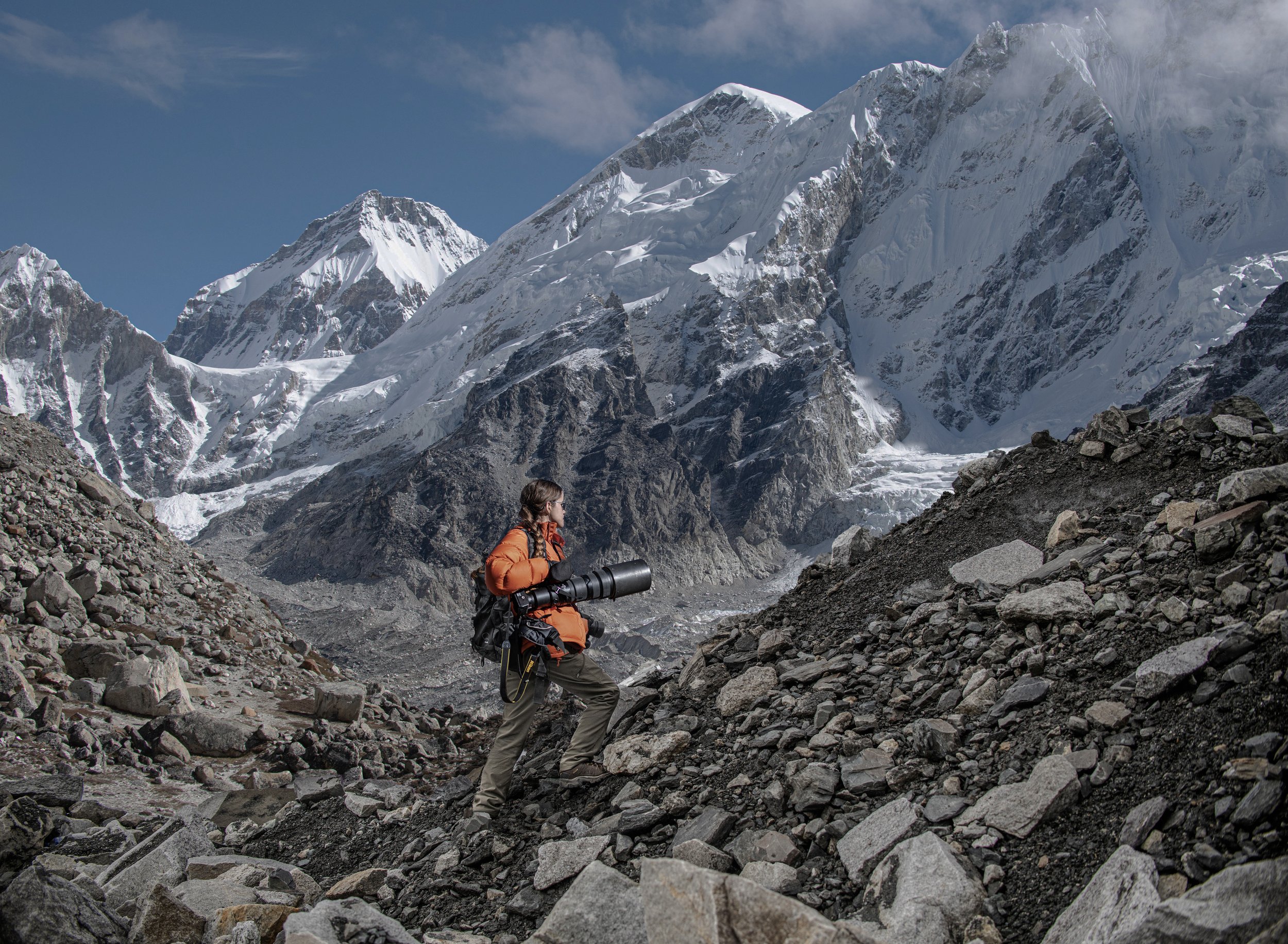
Lower Mustang, Nepal
My search began in the rugged Himalayan landscape of the 7,629 km2 Annapurna Conservation Area in north-central Nepal. From the dusty village of Jomsom, I headed North along the Kali Gandaki River into the Lower Mustang. Lupra, a dozen mud houses grouped about a monastery, marked my first stop in my search.
“The people here have tended livestock for generations, and they regard snow leopards as grave threats to their livelihoods,” says Yungdung Tsewang, a local guide.
“From time to time, blue sheep will pass through our village, but we try to keep them away since they attract snow leopards.”
Following a goat herder’s path above mud-and-timber houses clustered on steep hillsides. I discovered the first signs of the elusive snow leopard. It had rained the previous week, making these tracks fairly fresh.
From Jungle to Mountain
From the Annapurna Conservation Area, I headed east into the Everest Region where I would backpack Sagarmatha National Park.
The preliminary population estimate of snow leopards conducted by WWF in collaboration with the government's Department of National Parks and Wildlife Conservation (DNPWC) has showed the presence of about 300-400 snow leopards in Nepal.
Amid the dusty bedlam of Kathmandu, where a cacophony of motorcycle engines, truck horns, and chanting sidewalk monks fill the kerosene-laced air, I traveled to an airstrip en route to Lukla.

Sagarmatha (Mt. Everest) National Park
After a 7 hour ride to a small airstrip in the Tamakoshi River Valley, I boarded a plane that was as big as a school bus and seated 18 passengers. With no radar or navigation systems, the pilots are completely dependent on what they can see from the cockpit.
Within 3 minutes of boarding we were up in the air, and 20 minutes later were on the ground at the world’s most dangerous airport in Lukla. Over the past 20 years, there have been seven deadly crashes.
In Lukla, I connected with my team of guides, porters, and yaks that ferried our rations to the upper valleys of Sagarmatha National Park. From there we walked north through the crepuscular gorge of the Dudh Kosi, an icy, boulder-choked river that churned with glacial runoff.

On midafternoons, I rested in teahouses after covering 5 to 15 miles (8-24 kilometers)
In a land with no trees, the only source of warmth comes from small stoves packed with dried yak dung. Yak dung burns poorly, especially in the oxygen-depleted air of 16,000+ feet, and creates eye-watering smoke.
Teahouses typically only have one room with a stove, all the other rooms, including where you pitch your sleeping bag, are as cold as outside.
Evenings were spent around the fire. I bought a Nepali board game called Bagha Chal. A local told me this game was “played by his ancestors” and I ended up playing against many Sherpa in the teahouses en route to the Everest Region.
Khumbu Region
From Lukla, I walked into the upper valleys of Sagarmatha National Park. The tail end of the monsoon season lashed with downpours and snowstorms. Up, down, hot, cold, wet, sunburnt, exhausted, exhilarated; this was the daily routine as I cut across the pattern of rivers that drain the Himalayas into the Ganges.

On a bitterly cold morning, I followed the icy rim of a gaping chasm, scoping out the Khumbu Valley with my Nikkor 500mm f/4 lens. After finding snow leopard tracks outside Gorak Shep (16,942 ft / 5,164 meters), I was confident I would find something.
At 18,000 feet (5486 meters) the weather was unpredictable. Within minutes one was alternatively freezing or roasting in the sunshine. This altitude is the limit of where snow leopards roam; however, to get the best view of the valley, I had to climb.
Squinting through my camera’s telephoto lens, I noticed something in the shadow of Mount Pumori. At first I thought it was a rock, but it was exactly what I was looking for.
Khumbu Glacier, Nepal | Altitude 17,014 ft (5185 meters)
A snow leopard sits atop a chasm above a field of ice pinnacles called Phantom Alley.
October 9, the full moon washed the icy Himalayan peaks in ghostly light, obviating the need for a headlamp. Overnight, flurries of fine snow particles filled the air, soaking my sleeping bag in icy dew.
Snow leopards are most active around dawn and dusk. At 4 A.M. I put on my boots and set out. The night had a cold, phantasmal beauty. With 25 pounds of camera gear, I headed Northeast of Gorak Shep, and crossed a frozen lakebed. The snowy mountain slopes glittered like they were sown with diamonds.
After backpacking through Earth’s most forbidding terrain, lung-starving altitudes, soaring peaks, and high deserts—this was the most difficult and rewarding set of photos I’ve ever created.
Special thanks to Dipesh, Amish, Daniel, Dillion, Ace the Himalaya, and everyone who helped me.
Disclaimer: The images used in this story are creative artworks intended to tell a narrative and capture an emotion, not to serve as straightforward journalistic documentation. My creative process often involves digital composites and may include licensed stock elements, as is common practice in many forms of digital art. I am committed to respecting copyright and obtaining the appropriate licenses for all my work.




























